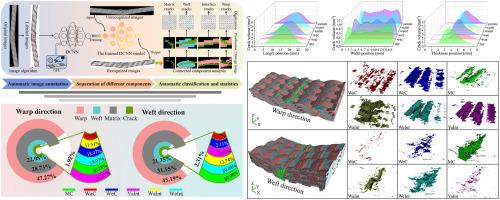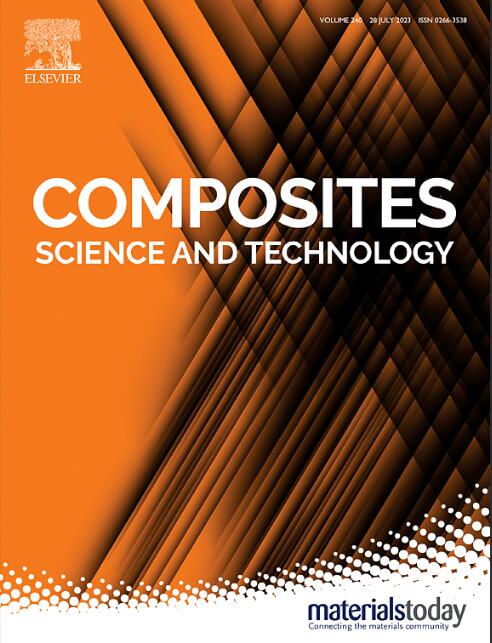基于深度学习策略的用于 2.5D 编织复合材料多模式损伤量化的改进型自动图像标记和分类算法
IF 8.3
1区 材料科学
Q1 MATERIALS SCIENCE, COMPOSITES
引用次数: 0
摘要
准确识别和量化编织复合材料中复杂的多模损伤对于评估组件的使用寿命和提高可靠性至关重要。然而,目前基于深度学习框架的先进方法仍以人工标注为主,导致纤维/树脂界面不清晰、微裂纹易被忽略、效率较低。为了克服这一问题,本文提出了一种基于深度学习策略的改进型自动图像标注和分类算法,用于量化 2.5D 编织复合材料的不确定性损伤。具体来说,利用灰度值和图像边界生成图像数据集的图像算法对原始微型计算机断层扫描(CT)图像进行自动标注。随后,利用图像数据集训练 DCNN 模型。然后,使用训练好的深度卷积神经网络(DCNN)模型来识别未见过的 CT 图像,并分离 2.5D 编织复合材料的损伤和不同子阶段。最后,引入连通成分分析法对中观尺度的全局裂纹进行分类。结果表明,所提出的自动图像标注和分类算法的损伤识别精度可达 85.87%,超过了其他模型。此外,还准确捕捉到了 2.5D 编织复合材料的多模式损伤。在经向,弯曲损伤累积主要表现为界面脱粘,占损伤百分比的 51.93%。在纬向,主要表现为基体开裂,占损伤百分比的 60.98%。该研究有望为大型复杂结构部件的应用提供数据支持。本文章由计算机程序翻译,如有差异,请以英文原文为准。

An improved automatic image labeling and classification algorithm for multi-mode damage quantification of 2.5D woven composites based on deep learning strategy
Accurately identifying and quantifying the complex multi-mode damages in woven composites is of vital importance to evaluate the service life and improve reliability of the components. However, the current advanced methods based on the deep learning framework remain mainly the manual labeling, resulting in unclear fiber/resin interfaces, easily-overlooked microcracks, and lower efficiency. To overcome the problem, this paper proposes an improved automatic image labeling and classification algorithm based on deep learning strategy to quantify the uncertainty damages of 2.5D woven composites. In detail, the original micro-computed tomography (CT) images are automatically labeled by an image algorithm that utilizes grayscale values and image boundaries to produce image datasets. Subsequently, the DCNN model is trained using the image datasets. Then, the trained deep convolutional neural networks (DCNN) model is used to identify unseen CT images and separate the damage and different sub-phases of 2.5D woven composites. Finally, the connected component analysis is introduced to classify the global cracks at the meso-scale. The results show that the proposed automatic image labeling and classification algorithm can achieve a damage identification precision of 85.87 %, surpassing that of other models. Moreover, the multi-mode damages of 2.5D woven composites are accurately captured. In the warp direction, the bending damage accumulation predominantly manifests as interface debonding, representing 51.93 % of the damage percentage. In the weft direction, it is primarily characterized by matrix cracking, representing 60.98 % of the damage percentage. It is expected that the study can provide data support for the application of large-scale and complex structural components.
求助全文
通过发布文献求助,成功后即可免费获取论文全文。
去求助
来源期刊

Composites Science and Technology
工程技术-材料科学:复合
CiteScore
16.20
自引率
9.90%
发文量
611
审稿时长
33 days
期刊介绍:
Composites Science and Technology publishes refereed original articles on the fundamental and applied science of engineering composites. The focus of this journal is on polymeric matrix composites with reinforcements/fillers ranging from nano- to macro-scale. CSTE encourages manuscripts reporting unique, innovative contributions to the physics, chemistry, materials science and applied mechanics aspects of advanced composites.
Besides traditional fiber reinforced composites, novel composites with significant potential for engineering applications are encouraged.
 求助内容:
求助内容: 应助结果提醒方式:
应助结果提醒方式:


